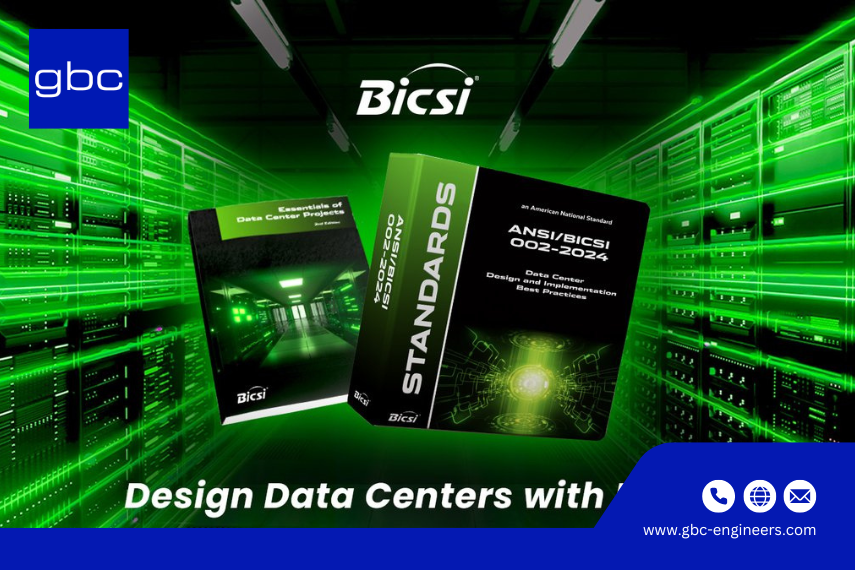In 2025, data centers have become the backbone of digital economies worldwide. With the rise of technologies like artificial intelligence, big data, and cloud computing, the demand for robust, scalable, and efficient data centers has never been higher.
To meet these demands, the industry has established various standards that guide the design, construction, and operation of data centers, ensuring that these facilities can withstand the challenges of a rapidly evolving technological landscape.
This detailed overview of gbc engineers will explore the most influential data center design standards shaping the industry today.
1. Uptime Institute’s Tier Standards: Benchmarking Data Center Resilience
The Uptime Institute’s Tier Standards are among the most recognized and globally adopted frameworks for evaluating the resilience of data centers. These standards provide a performance-based rating system to assess a facility's redundancy, fault tolerance, and overall equipment reliability, ensuring that it can continue to operate under various conditions without interruption. This system helps organizations learn how to select the right data center based on their resources and operational needs.
Tier I
The most basic level of infrastructure, with a single path for power and cooling. Tier I data centers are suited for small enterprises and offer an uptime of 99.671%. These facilities typically consist of basic IT support and dedicated cooling systems, with minimal redundancy. They are primarily used by businesses that do not require high availability and are more cost-effective in terms of resources but come with an increased risk of downtime.
Tier II
Offering 99.741% uptime, Tier II data centers introduce additional components like backup generators, energy storage, and advanced cooling systems. The key feature of Tier II facilities is that they allow for the removal or shutdown of certain equipment (such as cooling or power systems) for maintenance without impacting other parts of the system. This provides a higher level of resilience while allowing for some learn-based optimization through scheduled downtime for maintenance or upgrades.
Tier III
With 99.982% uptime, Tier III data centers are designed to handle critical operations. They have multiple paths for power, cooling, and IT systems, ensuring that the facility remains operational even during maintenance or failure of individual components. These systems are built with concurrent maintainability, meaning that they can be serviced or replaced without interrupting the flow of operations.
Tier III facilities are ideal for organizations that require continuous operation of their resources, such as cloud service providers or financial institutions.
Tier IV
The most robust data center standard, Tier IV facilities guarantee 99.995% uptime. Every component in a Tier IV data center has redundancy, and the facility is designed to be fault-tolerant, capable of withstanding multiple failures simultaneously. These data centers are built with physically isolated systems, which prevents one failure from affecting another, providing the highest level of operational reliability.
Tier IV data centers are typically used by enterprises that rely on mission-critical applications, where downtime is absolutely unacceptable, ensuring that resources and equipment remain continuously available.
The Uptime Institute’s Tier standards are crucial for organizations that need to select data center facilities that match their operational needs and risk tolerance. The rating system provides transparency, allowing clients to choose the most suitable option based on their requirements for uptime and resilience, helping them understand the level of investment needed to meet their performance objectives.
By understanding these standards, organizations can better learn about the equipment and resources required for their data center infrastructure and make more informed decisions.
Read More: Typical Data Center Layout: Core Components and Infrastructure - gbc engineers
2. ANSI/BICSI 002-2024: Global Design and Implementation Best Practices
The ANSI/BICSI 002-2024 standard is a cornerstone of data center design, providing a framework for the planning, construction, and operation of data centers. Developed by the Building Industry Consulting Service International (BICSI), this standard is widely recognized for its comprehensive coverage of critical systems such as mechanical, electrical, and plumbing (MEP), fire protection, and IT infrastructure.
This standard emphasizes the importance of designing data centers with flexibility and scalability in mind, ensuring they can adapt to the changing needs of modern computing. It caters to a range of data center types, including traditional, hyperscale, and edge facilities.
The 2024 update of the standard incorporates best practices for energy efficiency, sustainable design, and futureproofing, ensuring that data centers are prepared to meet the demands of emerging technologies such as cloud computing and AI.
Key elements covered in the standard include:
Site selection: The standard provides guidelines for choosing optimal locations that minimize risks such as natural disasters, power instability, or proximity to infrastructure. This is essential for ensuring uninterruptible power and protecting against external factors that could compromise the data center's performance.
Design and planning: Recommendations for ensuring that data centers have appropriate power, cooling, and redundancy mechanisms to handle increasing computational loads.
Sustainability: Best practices for integrating renewable energy sources and designing energy-efficient facilities that reduce carbon footprints. The standard promotes the use of technologies that not only support uninterruptible power but also optimize power usage to ensure data centers are both environmentally responsible and economically viable in the long term.
Risk management: Guidance on how to mitigate potential risks associated with natural disasters, hardware failure, or cyber threats.
By following ANSI/BICSI 002-2024, data center operators can ensure that their facilities are optimized for both performance and long-term sustainability, while also meeting the ever-growing demands for data processing.

3. ANSI/TIA-942 Revision C: Telecommunications Infrastructure Standard
The ANSI/TIA-942 Revision C standard is pivotal for designing data center telecommunications infrastructure. Issued by the Telecommunications Industry Association (TIA), this standard defines requirements for cable management, network redundancy, and the design of electrical and mechanical systems, ensuring that data center standards are met in terms of performance and reliability.
Key aspects of the ANSI/TIA-942 Revision C include:
Telecommunications cabling: Specifications for the types of cables and fiber optics required to support high-speed communication within the data center.
Redundancy: This framework incorporates redundancy and reliability guidelines, similar to the Uptime Institute’s Tier system, ensuring that facilities have multiple paths for communication and power.
Security: Guidelines for physical and logical security to protect the infrastructure from unauthorized access and cyber threats.
Environmental controls: Recommendations for the implementation of air conditioning, fire suppression, and cooling systems to maintain an optimal operating environment for IT systems.
In addition, the ANSI/TIA-942 framework ensures that facilities can handle growing demands for bandwidth, which is crucial in an era of rapid technological innovation and cloud-based services. By adhering to these guidelines, facilities can ensure reliable, high-performance operations, while also aligning with the privacy policy requirements to safeguard sensitive data and maintain compliance with privacy regulations.
Read More: Data Center Design 101: Key Principles Every Project Needs - gbc engineers
4. EN 50600 Series: European Standards for Data Center Facilities
The EN 50600 series is a set of international guidelines developed by the European Committee for Standardization (CEN). These guidelines are designed to help data centers achieve efficiency and resilience, integrating best practices from the Uptime Institute, TIA, and BICSI frameworks.
The series consists of several modules:
EN 50600-1: General concepts, including the overall design and infrastructure requirements for data centers.
EN 50600-2-1: Building construction, detailing the structural elements required to support a safe and resilient data center.
EN 50600-2-2: Power distribution, which outlines the systems necessary to ensure uninterrupted power supply.
EN 50600-2-3: Environmental control, ensuring the facility’s cooling systems are efficient and capable of handling rising IT loads.
EN 50600-2-5: Security systems, outlining how physical and network security should be implemented.
The EN 50600 series is applicable primarily in Europe but is also recognized globally. It offers a comprehensive set of requirements, covering every aspect of data center construction and operation, ensuring facilities are built to the highest standards of safety, reliability, and environmental sustainability.

5. SS 507: Singapore’s ICT Disaster Recovery Standard
The SS 507 standard, established in Singapore, outlines requirements for disaster recovery and business continuity for ICT infrastructure. With increasing concerns over data security and resilience, this standard has become a critical reference point for data centers operating in the region.
Key provisions include:
Disaster recovery planning: Guidelines for creating comprehensive disaster recovery strategies, including backup power systems and data replication techniques.
Business continuity: Ensuring that data centers can continue operations without significant interruptions, even during natural disasters or cyber incidents.
Security protocols: Incorporating strict security measures to safeguard against both physical and digital threats to data center operations.
This standard is especially relevant to organizations in the Asia-Pacific region, but it serves as a valuable resource for global operations looking to strengthen their disaster recovery frameworks.
Read More: Top 5 Data Center Technologies in 2025: Emerging & Networking - gbc engineers
6. Regulatory Standards: Ensuring Compliance and Security
Data centers must adhere to various regulatory guidelines to ensure legal compliance and meet industry-specific data protection guidelines. These regulations are especially important in industries handling sensitive information, such as healthcare, finance, and government.
Common regulatory guidelines include:
HIPAA (Health Insurance Portability and Accountability Act): Ensures the protection of personal health information in the U.S.
SOX (Sarbanes-Oxley Act): Mandates financial reporting guidelines, particularly relevant to financial institutions.
GLBA (Gramm-Leach-Bliley Act): Focuses on safeguarding private financial data.
Compliance with these guidelines is essential for data centers that handle regulated data, as it helps mitigate legal risks and protect client information.
7. Operational Standards: Maintaining Data Center Performance
Operational standards are crucial for maintaining the performance, security, and sustainability of data centers once they are operational. These standards ensure that facilities continue to meet their operational goals without compromising performance or safety.
Notable operational standards include:
ISO 9000: Quality management standards, ensuring operational excellence.
ISO 14000: Environmental management systems, promoting sustainability.
ISO 27001: Information security management systems, safeguarding sensitive data.
Operational standards also include guidelines for maintenance, repair protocols, and energy efficiency, ensuring that data centers can continue operating efficiently and safely over their lifespan.
Ready to Future-Proof Your Data Center?
Partner with gbc engineers to design a facility that delivers performance, reliability, and long-term value.
🌐 Visit: www.gbc-engineers.com
🏗️ Explore Our Services: Services - gbc engineers
Conclusion
The data center industry in 2025 is defined by its adherence to a variety of international and national standards, each addressing key aspects of design, construction, operation, and sustainability. By following these guidelines, data center operators can ensure the efficiency, reliability, and security of their facilities, while also complying with regulatory requirements and industry best practices.
As the digital world continues to evolve, these standards will remain crucial in ensuring that data centers are equipped to handle the increasing demands of the future.